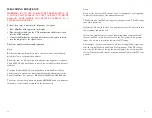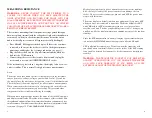
4
MEASURING AC/DC CURRENT
WARNINGS:
DO NOT APPLY VOLTAGE DIRECTLY ACROSS
THE 10A, 400mA, or /
.
mA TERMINALS. YOU MUST CONNECT
THE METER IN SERIES WITH THE CIRCUIT. THE 10A
TERMINAL IS NOT FUSED. A SEVERE FIRE HAZARD AND
SHORT CIRCUIT DANGER EXISTS IF YOU APPLY A VOLTAGE
WITH HIGH-CURRENT CAPABILITY TO THIS TERMINAL. THE
METER CAN BE DESTROYED UNDER SUCH CONDITIONS.
To measure current, break the circuit and connect the probes in series
with the circuit. Never connect the leads across a voltage source (in
parallel). Doing so can blow the fuse or damage the circuit under test.
The maximum current input limit is 10A.
• Press
VOLTS
/
AMPS
to select amps. A appears on the display.
• Press
AC
/
DC
to select DC or AC current measurement.
• Repeatedly press
VOLTS
/
AMPS
to set the range. Each time you press
VOLTS
/
AMPS
, the range changes.
• To measure a current that is less than or equal to 4000 A (4 mA),
plug the red test lead into the /
.
mA terminal.
• To measure a current between 4.000 mA and 400.0 mA, press
VOLTS
/
AMPS
again to select the 40.0 mA or 400.0 mA scale and plug
the red test lead into the 400 mA terminal.
• To measure a current greater than 400.0 mA, press
VOLTS
/
AMPS
again to select the 4.000 A or 10.00 A scale and plug the red test lead
into the 10A terminal.
Note: If you are not sure how much current the circuit you are testing
draws, start with the 10A range.
• Remove power from the circuit under test. Then, break the circuit at
the appropriate point.
• Connect the probes in series with the circuit.
• Apply power to the circuit.
• If the measurement is greater than the selected range, the meter
displays the overrange indication. (
Page 3,
OVERRANGE
INDICATION
.
)
Press
VOLTS
/
AMPS
to select a higher range, and plug the red test lead
into the appropriate terminal.
13
MANUALLY SELECTING THE RANGE
The meter automatically selects the best range for most applications.
For some situations, you might want to manually set the range. To
switch to the manual mode, press
AUTO
/
MAN
so that [
AUTO
] disappears
from the display. Then, press
RANGE
^
or
RANGE
to select the range.
To return to automatic range selection, press
AUTO
/
MAN
so that [
AUTO
]
appears on the display.
USING THE BAR GRAPH
In addition to the numeric display, the meter displays all measurements
on a bar graph at the bottom of the display. The bar graph is updated
more quickly than the digital display, and gives a better indication of
levels and trends for varying measurements. The bar graph has 41
marks. The first mark is always on, and indicates 0. Each additional
mark represents the first two digits in the display. For example, if the
displayed value is 1.853, 19 marks appear on the bar graph.
USING THE BEEP OPTION
You can have the meter beep when any of the following occurs:
• In the MIN/MAX mode, when the meter updates the minimum or
maximum value (
See page 14,
U
SING
THE
MIN/MAX M
EMORY
F
UNCTION
)
• When the meter automatically changes measurement ranges
• When you press one of the mode buttons
To have the meter beep, press
BEEP
. [
BEEP
] appears on the display.
To cancel the beep option, press
BEEP
again. [
BEEP
] disappears from
the display.
The meter always beeps in the continuity mode and when you switch to
the relative mode.








